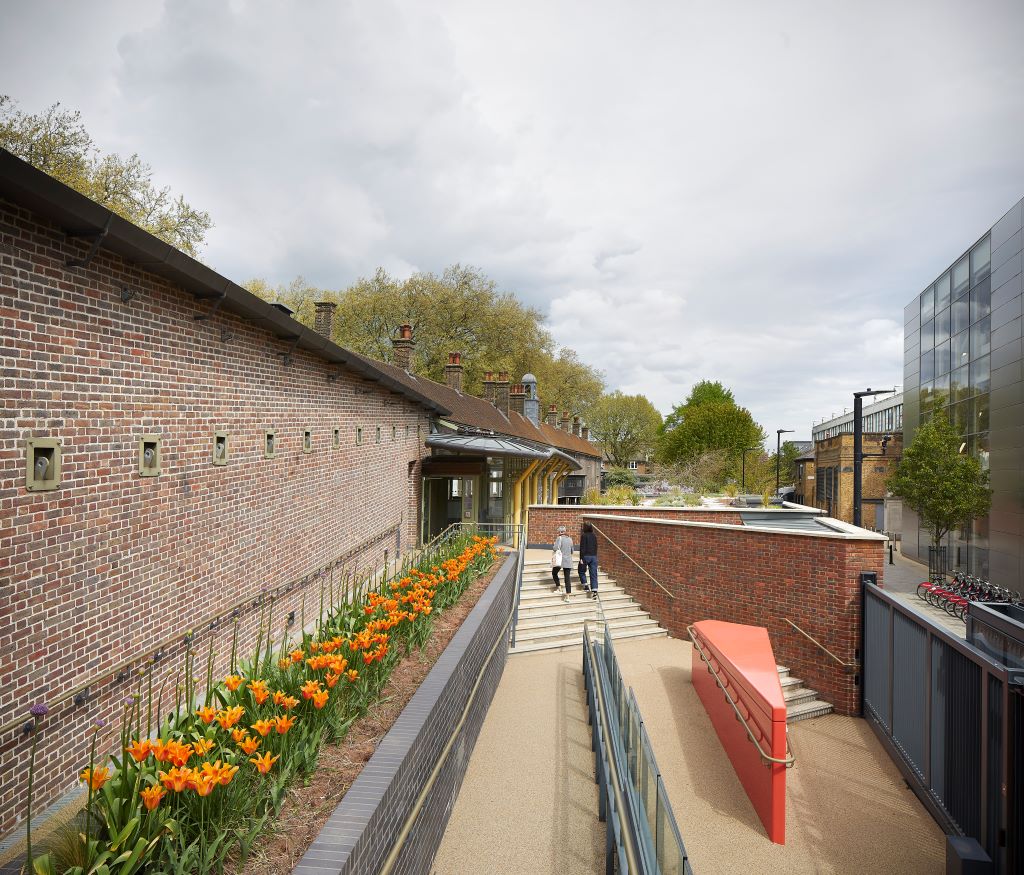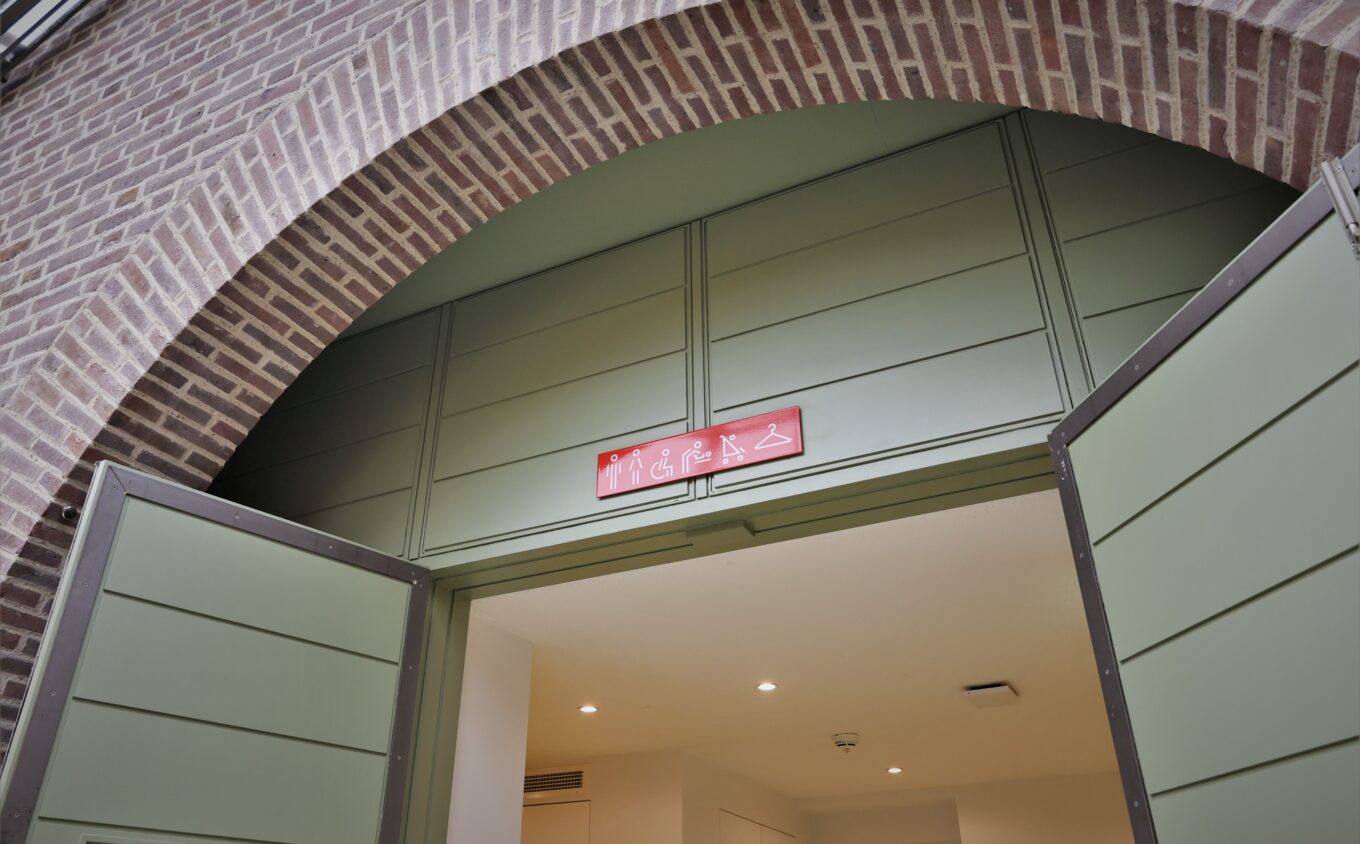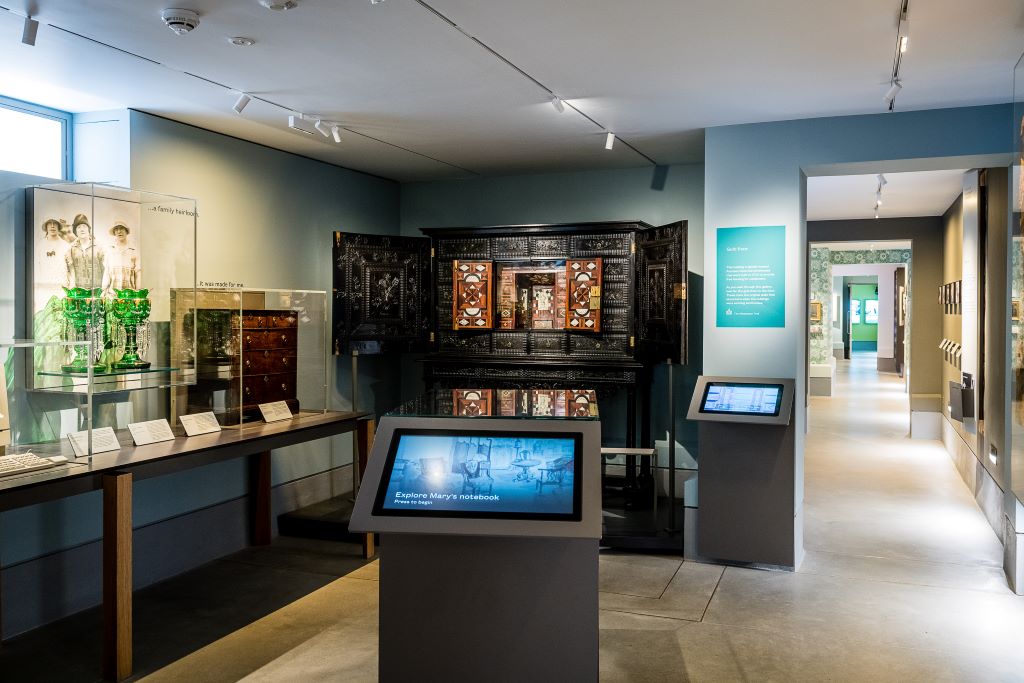Arriving at the museum
There are 15 steps from Geffrye Street to the main entrance. There is also a ramp which is 45 metres long in total in four sections, the longest of which is 14 metres. There are two sets of glass doors at the main entrance which open with a push pad.
There are three pedestrian gates on Kingsland Road leading to a large lawn area. At the central and north gates, ramps lead from the pavement down to a smooth and level path. The south gate does not have ramped access, but it does have a hand rail. At the entrance, three stone steps lead up from the path into the museum. There is also a 6 metre long ramp leading to a glass door that opens automatically.
The main entrance and the Kingsland Road entrance both lead into our welcome area. Our team wear orange lanyards and will welcome you to the museum and help you start your visit.
Entrance is free and you do not need to book in advance. When it is very busy, we might ask you to wait before entering the gallery spaces. This helps us to spread out visitors and create a more comfortable environment for everyone.
If you are attending a ticketed event, you must book a ticket in advance online from the event page. If there are any special instructions for your event, these will be sent to you by email before your event starts. For questions about your event, please get in touch with the team at bookings@museumofthehome.org.uk or call us on 020 7739 9893.
Our facilities
There is step-free access to all our galleries. There are small passenger lifts between floors and a vertical platform lift from the Home Galleries to the Gardens Through Time.
To access the Collections Display on the first floor, please ask a member of our team for assistance.
The floors inside the museum are a mix of concrete, wood and carpet. The paths in our gardens are a mix of brick paving and resin-bound gravel. There are ramps between different levels of the gardens. We try to make sure that our paving is swept regularly and gritted in cold weather.
There is an accessible toilet suitable for wheelchair users in the reception area and two further accessible toilets across the museum. All of our accessible toilets have a pull cord alarm.
There are gendered toilets in the reception area. The gendered toilets each include one ambulatory cubicle. This is a larger cubicle fitted with grab rails, suitable for you if you need more space but do not use a wheelchair.
There are also gender-neutral toilets available at the end of the Home Galleries.
The nearest Changing Places toilet is in Haggerston Park.
You can borrow a manual wheelchair for use in our galleries and gardens. If you would like to borrow a wheelchair, please ask at the information desk in the reception space when you arrive. You can’t book a wheelchair in advance.
We have three manual self-propelled wheelchairs. All our wheelchairs are suitable for users up to 135kg, have a 45cm wide seat, footrests, solid tyres and parking brakes.
Mobility scooter users are welcome throughout the museum. Some galleries are small and may be difficult to navigate in a Class 3 scooter.
There is an induction loop at Reception in the Welcome Area. There are also induction loops in the following event spaces:
- Studio
- Learning Pavilion
- Georgian Suite
Guide, assistance and emotional support animals, including dogs in training, are welcome at the museum. Please make sure your dog is wearing their tabard/harness and identify them to staff at Reception.
There are backless benches in the reception space and park benches in our gardens. You can borrow a lightweight folding stool at reception and in the gallery spaces. You can also use the stools in our gardens.
Drinking water is available from a tap in the Lunch Room, which is open to all. There is also a public water fountain just outside the museum’s Hoxton Station entrance.
In the galleries
Our object labels and interpretation text panels are at a suitable height for wheelchair users. There are large print guides at reception and at the entrance of every gallery space.
Interpretation and audio can also be accessed on your personal mobile device through our free digital guide with Bloomberg Connects.
All our films have subtitles or captions, and some have BSL interpretation.
Child-sized ear-defenders and backpacks filled with sensory toys are available to borrow from Reception during your visit, at no cost. We’ll ask to take your contact details when you borrow them.
Our quietest times are usually weekday and Sunday mornings. Our busiest time is usually between 12pm and 3pm on Saturdays, and during school holidays.
Some of our spaces, particularly some of the Rooms Through Time, are small and can feel busy. Quieter spaces away from the main galleries include the Lunch Room and the Gardens Through Time.
Temporary exhibitions may include flashing lights that could trigger photosensitive migraine or epilepsy. Signage is in place to warn you before such spaces. Where possible, we make an alternative route available.
The lighting, temperature, smells and sounds vary across the museum. We have listed the main sensory features of each permanent gallery space below.
For temporary exhibitions, we will provide key sensory information on our website and on signage before you enter the space.
Reception
- Bright natural and artificial light
- Cooler temperature
- Well-ventilated
- Some alarms occasionally sound at the information desk
- Can be loud when groups gather for tours and children play in this space
Home Galleries
- Subdued artificial light
- Warmer temperature
- Some artificial smells in interactive exhibit
- Some audio that plays out loud
Rooms Through Time
- Subdued natural light and subdued artificial light
- Cooler temperature
- Some audio that plays out loud
- Family activity space can be loud
We are committed to exploring the lived experiences of home by individuals and communities through time. Our permanent and temporary exhibitions include themes of migration, grief, loss, and slavery.
Love and Loss in the Home Galleries includes themes of death, mourning, disappearance and grief.
The statue of Robert Geffrye on the museum’s buildings acknowledges his donation to build the almshouses and reflects the historic connection the museum buildings have to Geffrye, an English merchant who made part of his money from his investment in transatlantic slavery. Geffrye is not connected to the founding of the museum or its collections. Find out more about what we are doing to better reflect our values and be a welcome place for all.
You may hear alarm sounds near Reception in the Welcome Area. These are managed by our staff and are nothing to worry about.
The fire alarm is a loud sound that you can hear throughout the building. There are also visual alarm indicators mounted on the ceiling that flash red when the alarm is active. If the fire alarm sounds during your visit, our team will show you the quickest and safest way to leave the building.
If we are planning a fire drill, signage will be in place in the reception area and our team will tell you what to expect when you arrive.
You can explore the museums using your own smartphone with Bloomberg Connects, the free arts and culture app. QR codes are located throughout the galleries and in the Welcome Area.
To access the web app or mobile app, you must be connected to mobile data or our free wifi (Home_Guest). Ask a member of staff if you require assistance with connecting.
We continue to improve our web accessibility on this website. Read our website accessibility statement.
Should you find we are not meeting requirements or would like to make a suggestion that could improve your online experience, please contact our team at digital@museumofthehome.org.uk.

Free digital guide
Explore Museum of the Home with our digital guide on Bloomberg Connects, the free arts and culture app.


